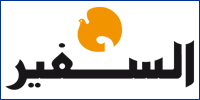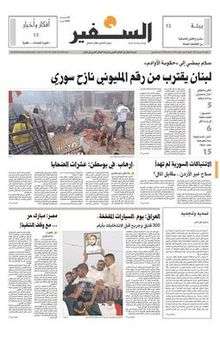As-Safir
As-Safir (Arabic: السفير), meaning The Ambassador, was a leading Arabic-language daily newspaper in Lebanon. The headquarters of the daily is in Beirut.[3] It has been in circulation from March 1974 until December 2016.[4] The last issue of the paper was published on 31 December 2016. The online version was also closed on the same date.[4]
 | |
 As-Safir front page, 16 April 2013 | |
| Type | Daily newspaper |
|---|---|
| Format | Broadsheet |
| Publisher | Dar Al Safir |
| Editor | Talal Salman |
| Founded | 26 March 1974 |
| Political alignment | Pan-Arab[1][2] |
| Language | Arabic |
| Ceased publication | 31 December 2016 |
| Headquarters | Beirut, Lebanon |
| Circulation | 50,000 (2012) |
| Website | Official website |
History and profile
As-Safir was first published by Talal Salman on 26 March 1974 as an Arabic political daily.[5][6] Talal Salman also served as chief editor of the paper.[7] In 2005, the daily's chief editor was late Joseph Samaha.[8][9] The publisher of the daily is Dar Al Safir.[3] It is published in broadsheet format.[10]
On 18 July 2011, the paper, together with Al Akhbar, another daily published in Lebanon, was banned in Syria.[11]
As-Safir had a weekly page on the environmental issues.[12]
Political approach
As-Safir stated its mission as to be "the newspaper of Lebanon in the Arab world and the newspaper of the Arab world in Lebanon." (in Arabic جريدة لبنان في الوطن العربي وجريدة الوطن العربي في لبنان)[13] This remained the slogan printed on the paper's masthead.[6] It also adopted the slogan "The voice of voiceless" (in Arabic صوت اللذين لا صوت لهم) The paper provided an independent voice for the left-wing, Pan-Arab tendency which was increasingly active in Lebanese intellectual and political life in the years after the Arab defeat in the Six-Day War. It also focused on issues pertaining to the Muslim world, advocated Arab nationalism, was close to Hezbollah and had a pro-Syrian stance.[14]
Another Lebanese daily, An-Nahar, was cited as the biggest rival of As-Safir.[15] In the mid-1990s, the paper was described as a left-of-center paper, whereas An-Nahar as a right-of-center paper.[16] During the same period, As-Safir was also described by Robert Fisk as a Syrian-backed newspaper.[17] In the 2000s these papers were again supporters of two opposite poles in Lebanon, in that An-Nahar is a supporter of March 14 alliance, whereas As-Safir supported March 8 alliance.[18]
Circulation and websites
As-Safir had the second highest circulation in the 1990s after An-Nahar.[16] Its circulation was 45,000 copies in 2003, being the second best selling paper in Lebanon.[10] In 2012, the Lebanese Ministry of Information stated that the daily had a circulation of 50,000 copies, being the first in the country.[5][18][19]
In addition to its Arabic website, the paper had also an English website.[20] The paper's online version was the 16th most visited website for 2010 in the MENA region.[21]
See also
References
- Nick Cumming-Bruce (18 February 2013). "U.N. Rights Officials Urge Syria War Crimes Charges". The New York Times. Retrieved 26 April 2015.
The pro-Assad Lebanese newspaper As-Safir
- Tony Badran (25 April 2013). "Assad reading the signs". NOW News. Retrieved 27 April 2015.
The Pro-Assad regime Lebanese newspaper As-Safir
- "Media Landscape". Menassat. Archived from the original on 20 February 2019. Retrieved 22 September 2013.
- "Lebanese newspaper As-Safir to stop publishing after 40 years". An Nahar. 9 December 2016. Retrieved 1 March 2020.
- "Lebanon. Media Landscape". European Journalism Center. Archived from the original on 8 September 2014. Retrieved 15 September 2014.
- "Lebanon" (PDF). Publicitas. Archived from the original (PDF) on 2 December 2012. Retrieved 8 June 2012.
- Yehia, Ranwa (27 January – 2 February 2000). "Salam bid farewell". Al Ahram Weekly. 466. Retrieved 27 March 2013.
- Mouawad, Jad (9 March 2005). "Lebanese Lawmakers Bring Back Pro-Syrian Prime Minister". The New York Times. Retrieved 18 March 2013.
- Assir, Serene (21–27 April 2005). "Divided we fall". Al Ahram Weekly. 739. Retrieved 15 April 2013.
- "World Press Trends" (PDF). Paris: World Association of Newspapers. 2004. Retrieved 15 February 2015.
- "Press and Cultural Freedom in Lebanon, Syria, Jordan and Palestine" (Annual report). SKeyes. 2011. Retrieved 10 October 2014.
- Najib Saab. "The Environment in Arab Media" (PDF). Arab Forum for Environment and Development. Archived from the original (Report) on 10 October 2014. Retrieved 7 October 2014.
- Dany Badran (2013). "Democracy and Rhetoric in the Arab World". The Journal of the Middle East and Africa. 4 (1): 65–86. doi:10.1080/21520844.2013.772685.
- "Mikati unveils 30-member Cabinet dominated by Hizbullah and March 8 allies". The Daily Middle East Reporter. 14 June 2011. Retrieved 10 March 2013.
- Fakih, Mohalhel (2–8 September 2004). "Pulling at Lebanon's strings". Al Ahram Weekly. 706. Retrieved 19 April 2013.
- Yahya R. Kamalipour; Hamid Mowlana (1994). Mass Media in the Middle East: A Comprehensive Handbook. Westport, CT: Greenwood Press. Retrieved 9 September 2013. – via Questia (subscription required)
- Robert Fisk (13 May 1993). "Beirut newspaper defies closure: Lebanese officials say left-wing daily 'endangered security of the state' with peace talks report". The Independent. Beirut. Retrieved 31 July 2014.
- "Mapping Digital Media: Lebanon" (PDF). Open Society Foundations. 15 March 2012. Retrieved 19 September 2013.
- "Lebanon Press". Press Reference. Retrieved 27 September 2013.
- "English - جريدة السفير".
- "Forbes Releases Top 50 MENA Online Newspapers; Lebanon Fails to Make Top 10". Jad Aoun. 28 October 2010. Retrieved 11 September 2014.